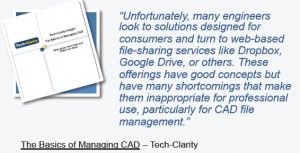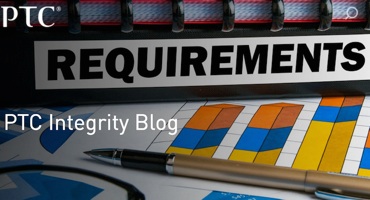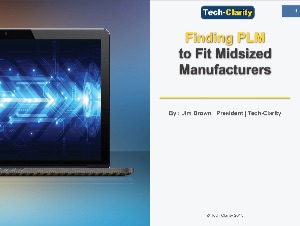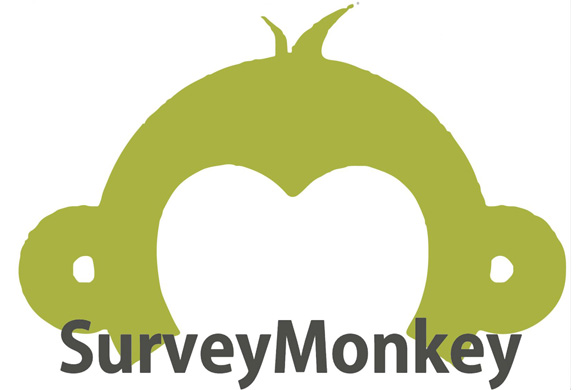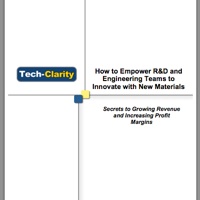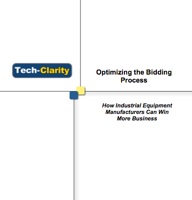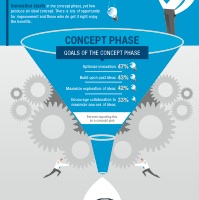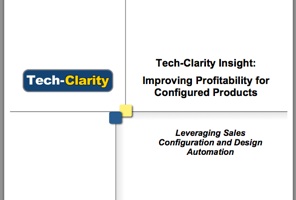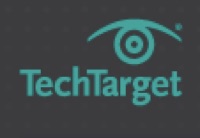Michelle Boucher shares six reasons why product development projects fail and they all stem from poor requirements management. The guest post titled 6 Reasons Your Projects Fail: How Requirements Management Can Help on the PTC Integrity blog, explores the impact of these six challenges on project success and discusses various ways poor requirements management can derail a project. Read the post on…
- Product and organizational complexity drive them beyond basic PDM capabilities
- A full-featured PLM implementation may feel out of reach
Get Started with the Right PLM Solution
Core PLM can quickly add value to midsized manufacturers by helping them combat complexity, improve productivity, and stay closer to customers. Recognize the potential value of a fully featured PLM with all of the bells and whistles, but be honest with yourself about whether your company can afford the time and effort to get there (at least right away). Don’t take on too much. Start with the basics and get value quickly, but recognize the shortcomings of simple file sharing solutions that fall short for the complex products and product development environments common to midsize manufacturers. Look for a solution that allows you to design in the context of your products in real time, but also in the context of processes and product development projects. In addition, look for PLM that incorporates automation including automatic CAD and project updates to keep engineers focused on innovation instead of managing files. Finally, make sure to leave your company room to grow as your business dictates, using the initial implementation as a foundation for greater improvements. *This summary is an abbreviated version of the report and does not contain the full content. A link to download the full report is available above. If you have difficulty obtaining a copy of the report, please contact us using the "Contact" link below. [post_title] => Finding PLM to Fit Midsized Manufacturers eBook [post_excerpt] => [post_status] => publish [comment_status] => open [ping_status] => open [post_password] => [post_name] => midsize-plm [to_ping] => [pinged] => [post_modified] => 2022-11-14 22:28:09 [post_modified_gmt] => 2022-11-15 03:28:09 [post_content_filtered] => [post_parent] => 0 [guid] => http://tech-clarity.com/?p=5236 [menu_order] => 0 [post_type] => post [post_mime_type] => [comment_count] => 0 [filter] => raw ) [2] => WP_Post Object ( [ID] => 5226 [post_author] => 2572 [post_date] => 2016-04-04 12:07:30 [post_date_gmt] => 2016-04-04 16:07:30 [post_content] =>- Luis Baldez, Software Strategy Program Manager, 3D Printing, HP
- Prabhjot Singh, Manager, Additive Manufacturing Lab, GE Global Research
- Simon Floyd, Director Strategy, Product Lifecycle Management, Microsoft
How do leading companies empower design engineers with simulation?
 Please share your experience. We are conducting new research on simulation and exploring questions such as how does simulation help design engineers? What are the best ways to help design engineers adopt simulation tools? What should you look for in a simulation solution for design engineers?
Please share your experience. We are conducting new research on simulation and exploring questions such as how does simulation help design engineers? What are the best ways to help design engineers adopt simulation tools? What should you look for in a simulation solution for design engineers?
- If you already completed the survey –> please share with a colleague by emailing a link to this page or select the “Share/Save” button above, which also includes social media options.
- If you haven’t taken the survey –> please:
CLICK HERE TO TAKE THE SURVEY NOW!
 In addition, 25 respondents will receive a $20 Amazon gift card. See rules and eligibility requirements below.
The survey should take about 10 minutes or less to complete. Individual responses will be kept confidential.
Thank you for your help and support!
In addition, 25 respondents will receive a $20 Amazon gift card. See rules and eligibility requirements below.
The survey should take about 10 minutes or less to complete. Individual responses will be kept confidential.
Thank you for your help and support!
Rules
To be eligible for this offer, you must complete the survey and be a professional with job responsibilities related to or supporting the development, release, or manufacture of products. Vendors and consultants who sell software, solutions, or services to support product development are not eligible. Students without relevant professional work experience are also not eligible. A valid work email is required to receive the gift card. To verify eligibility, your work email must include the domain of your place of employment. Email addresses will be kept confidential and will not be used for any direct sales or marketing purposes. Duplicate responses will be disqualified. Winners will be notified when the survey is closed.
[post_title] => Simulation Study: Empowering Innovation [post_excerpt] => [post_status] => publish [comment_status] => open [ping_status] => open [post_password] => [post_name] => design-simulation-survey [to_ping] => [pinged] => [post_modified] => 2024-01-20 00:53:02 [post_modified_gmt] => 2024-01-20 05:53:02 [post_content_filtered] => [post_parent] => 0 [guid] => http://tech-clarity.com/?p=5193 [menu_order] => 0 [post_type] => post [post_mime_type] => [comment_count] => 4 [filter] => raw ) [4] => WP_Post Object ( [ID] => 5182 [post_author] => 2572 [post_date] => 2016-03-21 12:10:51 [post_date_gmt] => 2016-03-21 16:10:51 [post_content] =>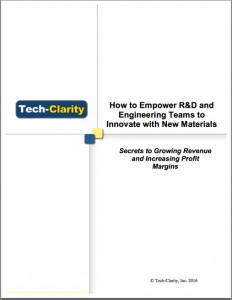 How to Empower R&D and Engineering Teams to Innovate with New Materials: Secrets to Growing Revenue and Increasing Profit Margins identifies six lessons to help companies innovate to secure future revenue streams, while managing risk. The study examines how new materials can help companies innovate and how more successful companies take advantage of the latest developments in materials.
Please enjoy the summary below, or click the report to download a PDF overview (free of charge, no registration required).
For the full report please visit our sponsor, Elsevier (free of charge, registration required).
How to Empower R&D and Engineering Teams to Innovate with New Materials: Secrets to Growing Revenue and Increasing Profit Margins identifies six lessons to help companies innovate to secure future revenue streams, while managing risk. The study examines how new materials can help companies innovate and how more successful companies take advantage of the latest developments in materials.
Please enjoy the summary below, or click the report to download a PDF overview (free of charge, no registration required).
For the full report please visit our sponsor, Elsevier (free of charge, registration required).
Table of Contents
- Executive Overview
- Business Drivers for Innovation
- Identifying the Top Performers
- Lesson #1: Understand the Opportunities in New Materials
- Lesson #2: Consider How To Balance Different Levels Of Innovation
- Lesson #3: Implement the Right Innovation Strategies
- Lesson #4: Prioritize Resources and Processes That Help Accelerate Discovery and Commercialization
- Lesson #5: Successfully Transition From Concept to Manufacture at Scale By Looking at the Entire System
- Conclusion
- Recommendations
- About the Author
- About the Research
Executive Overview
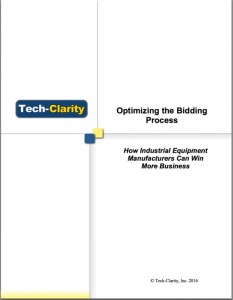 Optimizing the Bidding Process: How Industrial Equipment Manufacturers Can Win More Business focuses on the importance of getting the bidding process right. Bids require a quick response, yet must be competitively priced, without sacrificing margins. Getting this right is a challenge for many companies, but is especially difficult for businesses such as industrial equipment manufacturers offering Engineer-to-Order products. This report identifies best practices for quickly delivering an accurate, yet competitive bid.
Please enjoy the summary below, or click the report or title to download the full PDF (free of charge, no registration required).
For for more information on bidding for Engineer-to-Order products, please visit our sponsor, Autodesk.
Optimizing the Bidding Process: How Industrial Equipment Manufacturers Can Win More Business focuses on the importance of getting the bidding process right. Bids require a quick response, yet must be competitively priced, without sacrificing margins. Getting this right is a challenge for many companies, but is especially difficult for businesses such as industrial equipment manufacturers offering Engineer-to-Order products. This report identifies best practices for quickly delivering an accurate, yet competitive bid.
Please enjoy the summary below, or click the report or title to download the full PDF (free of charge, no registration required).
For for more information on bidding for Engineer-to-Order products, please visit our sponsor, Autodesk.
Table of Contents
- Executive Overview
- Review your Bidding Process
- Win More Business
- Win Customer Loyalty
- Prepare for the Future
- Extend Bid Automation to Engineering
- Enable Collaboration
- Select the Right Vendor
- Conclusion
- Recommendations
- About the Author
Executive Overview
- Grown revenue 2.2 times more than their lesser performing competitors
- Increased profit margins 2.4 times more than average performing companies
 [post_title] => Infographic: Improving Concept Design to Boost Revenue
[post_excerpt] =>
[post_status] => publish
[comment_status] => open
[ping_status] => open
[post_password] =>
[post_name] => infographic-concept-design
[to_ping] =>
[pinged] =>
[post_modified] => 2022-11-14 22:27:51
[post_modified_gmt] => 2022-11-15 03:27:51
[post_content_filtered] =>
[post_parent] => 0
[guid] => http://tech-clarity.com/?p=5067
[menu_order] => 0
[post_type] => post
[post_mime_type] =>
[comment_count] => 0
[filter] => raw
)
[7] => WP_Post Object
(
[ID] => 5087
[post_author] => 2572
[post_date] => 2016-02-23 11:24:43
[post_date_gmt] => 2016-02-23 16:24:43
[post_content] =>
[post_title] => Infographic: Improving Concept Design to Boost Revenue
[post_excerpt] =>
[post_status] => publish
[comment_status] => open
[ping_status] => open
[post_password] =>
[post_name] => infographic-concept-design
[to_ping] =>
[pinged] =>
[post_modified] => 2022-11-14 22:27:51
[post_modified_gmt] => 2022-11-15 03:27:51
[post_content_filtered] =>
[post_parent] => 0
[guid] => http://tech-clarity.com/?p=5067
[menu_order] => 0
[post_type] => post
[post_mime_type] =>
[comment_count] => 0
[filter] => raw
)
[7] => WP_Post Object
(
[ID] => 5087
[post_author] => 2572
[post_date] => 2016-02-23 11:24:43
[post_date_gmt] => 2016-02-23 16:24:43
[post_content] => 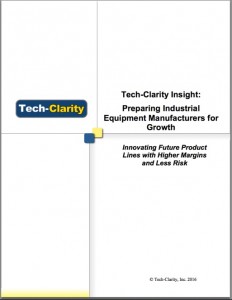 Preparing Industrial Equipment Manufacturers for Growth: Innovating Future Product Lines with Higher Margins identifies how industrial equipment manufacturers can transform their business to a position of growth by implementing a strategy for innovation, without investing in additional resources. With the right approach to innovation, companies will ensure future revenue streams, while managing risk. Getting this right is a challenge for many companies, but is especially difficult for businesses such as industrial equipment manufacturers offering Engineer-to-Order products. This report discusses best practices for becoming more innovative, while meeting the demands of on-time delivery for current projects with current resources.
Please enjoy the summary below, or click the report or title to download the full PDF (free of charge, no registration required).
For for more information on improving innovation processes, please visit our sponsor, Autodesk.
Preparing Industrial Equipment Manufacturers for Growth: Innovating Future Product Lines with Higher Margins identifies how industrial equipment manufacturers can transform their business to a position of growth by implementing a strategy for innovation, without investing in additional resources. With the right approach to innovation, companies will ensure future revenue streams, while managing risk. Getting this right is a challenge for many companies, but is especially difficult for businesses such as industrial equipment manufacturers offering Engineer-to-Order products. This report discusses best practices for becoming more innovative, while meeting the demands of on-time delivery for current projects with current resources.
Please enjoy the summary below, or click the report or title to download the full PDF (free of charge, no registration required).
For for more information on improving innovation processes, please visit our sponsor, Autodesk.
Table of Contents
- Executive Overview
- Why Should IEMs Care about Innovation?
- Clarify the Meaning of Innovation
- Identify Challenges that Hurt Innovation Success
- Establish a Culture of Innovation
- Invest in the Concept Phase
- Define Processes
- Take Advantage of Available Technologies
- Conclusion
- Recommendations
- About the Author
Executive Overview
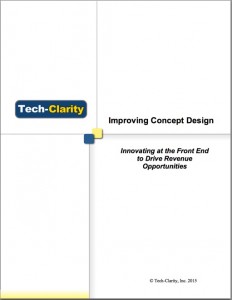 Improving Concept Design: Innovating at the Front End to Drive Revenue Opportunities examines the importance of the concept phase. The report reveals survey results highlighting not only what companies can do to improve the concept phase, but also how to take advantage of concept work during later stages of product development.
Please enjoy the summary below, or click the report or title to download the full PDF (free of charge, no registration required).
Additional information can be found in our companion infographic.
For for more information on concept design, please visit our sponsor, Siemens.
Improving Concept Design: Innovating at the Front End to Drive Revenue Opportunities examines the importance of the concept phase. The report reveals survey results highlighting not only what companies can do to improve the concept phase, but also how to take advantage of concept work during later stages of product development.
Please enjoy the summary below, or click the report or title to download the full PDF (free of charge, no registration required).
Additional information can be found in our companion infographic.
For for more information on concept design, please visit our sponsor, Siemens.
Table of Contents
- Executive Overview
- Understand the Importance of the Concept Phase
- Identifying the Top Performers
- Optimize the Conceptual Phase Recognize the Challenges of Concept Development
- Manage the Concept Phase
- Facilitate Collaboration
- Enable Reuse Capture
- Engineering Knowledge
- Conclusion
- Recommendations
- About the Author
- About the Research
Executive Overview
- Only 52% of the concept is reused during detail design
- Companies agree more should be reused
- Companies believe they would save 45% of overall development time by optimizing concept design reuse
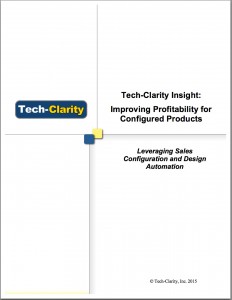 Improving Profitability for Configured Products: Leveraging Sales Configuration and Design Automation explores how companies can profitability tailor products to meet customer needs. The research investigates the experiences of several companies, revealing several key areas companies should focus on to improve their profitability.
Please enjoy the summary below, or click the report to download a PDF overview (free of charge, no registration required).
For the full report, please visit our sponsor, DriveWorks, (free of charge, no registration required).
Improving Profitability for Configured Products: Leveraging Sales Configuration and Design Automation explores how companies can profitability tailor products to meet customer needs. The research investigates the experiences of several companies, revealing several key areas companies should focus on to improve their profitability.
Please enjoy the summary below, or click the report to download a PDF overview (free of charge, no registration required).
For the full report, please visit our sponsor, DriveWorks, (free of charge, no registration required).
Table of Contents
- Executive Overview
- Optimize Profitability
- Support Guided Selling
- Automate Manufacturability Checks
- Streamline Sales to Manufacturing
- Create More Revenue Opportunities
- Enable ETO Best Practices
- Ensure Quote Accuracy
- Integrate to the Enterprise
- Enable Web and Mobile Platforms
- Keep the Implementation Simple
- Conclusion
- Recommendations
- About the Author
Executive Overview
Manufacturers have a tough job competing in today’s global environment. Global competition, price sensitivity, time to market pressures, and increasing complexity all make it very difficult for manufacturers to be successful. Competitively differentiating your business and its products is hard while facing all these pressures. In addition, customers expect more. To capitalize on this trend, a company can set itself and its products apart by tailoring products to customer needs with a Design to Order (DTO), Configure to Order (CTO), or Engineer to Order (ETO) strategy. Among the many benefits, customization and personalization:- Offer customers exactly what they want
- Create competitive differentiation
- Enable a price premium
- Higher productivity
- More accurate quotes
- Fewer errors
- Optimized manufacturing processes
- Less waste
 Jim Brown offers some advice on selecting PLM systems in this TechTarget article A PLM Systems Comparison of the Industry's Top Tools. The report also shares some insights on the leading PLM vendors.
This is the final article of a four part series. Prior article What can PLM technology dor for Enterprises? explores the benefits of PLM and PLM tools can cure and prevent product development ailments describes who can benefit from Product Lifecycle Management. The previous article, Choosing a PLM System? Start with Strategy! provides practical advice on choosing a PLM tool.
Jim Brown offers some advice on selecting PLM systems in this TechTarget article A PLM Systems Comparison of the Industry's Top Tools. The report also shares some insights on the leading PLM vendors.
This is the final article of a four part series. Prior article What can PLM technology dor for Enterprises? explores the benefits of PLM and PLM tools can cure and prevent product development ailments describes who can benefit from Product Lifecycle Management. The previous article, Choosing a PLM System? Start with Strategy! provides practical advice on choosing a PLM tool.
 [post_title] => Selecting the Right PLM Partner
[post_excerpt] =>
[post_status] => publish
[comment_status] => open
[ping_status] => open
[post_password] =>
[post_name] => tech-target-4
[to_ping] =>
[pinged] =>
[post_modified] => 2022-11-14 22:25:53
[post_modified_gmt] => 2022-11-15 03:25:53
[post_content_filtered] =>
[post_parent] => 0
[guid] => http://tech-clarity.com/?p=5040
[menu_order] => 0
[post_type] => post
[post_mime_type] =>
[comment_count] => 0
[filter] => raw
)
[12] => WP_Post Object
(
[ID] => 4969
[post_author] => 2
[post_date] => 2016-01-20 12:08:14
[post_date_gmt] => 2016-01-20 17:08:14
[post_content] => Jim Brown joins Mark Rogers of Price HVAC and Rick Smith of Siemens PLM to discuss how to improve ETO processes and performance. Jim will share findings from a recent survey on what strategies, best practices, and enabling technologies top performing manufacturers use to gain higher profits from their customized products.
Register now (free of charge, registration required)
[post_title] => Selecting the Right PLM Partner
[post_excerpt] =>
[post_status] => publish
[comment_status] => open
[ping_status] => open
[post_password] =>
[post_name] => tech-target-4
[to_ping] =>
[pinged] =>
[post_modified] => 2022-11-14 22:25:53
[post_modified_gmt] => 2022-11-15 03:25:53
[post_content_filtered] =>
[post_parent] => 0
[guid] => http://tech-clarity.com/?p=5040
[menu_order] => 0
[post_type] => post
[post_mime_type] =>
[comment_count] => 0
[filter] => raw
)
[12] => WP_Post Object
(
[ID] => 4969
[post_author] => 2
[post_date] => 2016-01-20 12:08:14
[post_date_gmt] => 2016-01-20 17:08:14
[post_content] => Jim Brown joins Mark Rogers of Price HVAC and Rick Smith of Siemens PLM to discuss how to improve ETO processes and performance. Jim will share findings from a recent survey on what strategies, best practices, and enabling technologies top performing manufacturers use to gain higher profits from their customized products.
Register now (free of charge, registration required)
 [post_title] => Webcast Driving a Competitive Edge Through Customization
[post_excerpt] =>
[post_status] => publish
[comment_status] => open
[ping_status] => open
[post_password] =>
[post_name] => etowebcast
[to_ping] =>
[pinged] =>
[post_modified] => 2025-01-31 11:39:19
[post_modified_gmt] => 2025-01-31 16:39:19
[post_content_filtered] =>
[post_parent] => 0
[guid] => http://tech-clarity.com/?p=4969
[menu_order] => 0
[post_type] => post
[post_mime_type] =>
[comment_count] => 0
[filter] => raw
)
[13] => WP_Post Object
(
[ID] => 4975
[post_author] => 2572
[post_date] => 2016-01-18 15:25:57
[post_date_gmt] => 2016-01-18 20:25:57
[post_content] =>
[post_title] => Webcast Driving a Competitive Edge Through Customization
[post_excerpt] =>
[post_status] => publish
[comment_status] => open
[ping_status] => open
[post_password] =>
[post_name] => etowebcast
[to_ping] =>
[pinged] =>
[post_modified] => 2025-01-31 11:39:19
[post_modified_gmt] => 2025-01-31 16:39:19
[post_content_filtered] =>
[post_parent] => 0
[guid] => http://tech-clarity.com/?p=4969
[menu_order] => 0
[post_type] => post
[post_mime_type] =>
[comment_count] => 0
[filter] => raw
)
[13] => WP_Post Object
(
[ID] => 4975
[post_author] => 2572
[post_date] => 2016-01-18 15:25:57
[post_date_gmt] => 2016-01-18 20:25:57
[post_content] =>
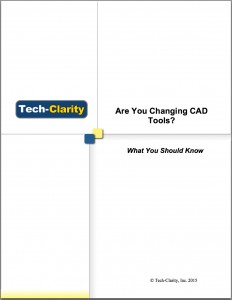 Are You Changing CAD Tools? What You Should Know shares survey results exploring the motivating factors behind changing CAD tools as well what companies can expect when making a change. The research examines the experiences of companies who have gone through a CAD change. It reveals key metrics such as the how much legacy data companies convert, how long to resume full productivity, and how much training is involved. The research also identifies what Top Performing companies look for in both a CAD tool and the vendor who provides that tool.
Please enjoy the summary below, or click the report to download a PDF overview (free of charge, no registration required).
For the full report, please visit our sponsor, Dassault Systèmes SOLIDWORKS, (free of charge, registration required).
Are You Changing CAD Tools? What You Should Know shares survey results exploring the motivating factors behind changing CAD tools as well what companies can expect when making a change. The research examines the experiences of companies who have gone through a CAD change. It reveals key metrics such as the how much legacy data companies convert, how long to resume full productivity, and how much training is involved. The research also identifies what Top Performing companies look for in both a CAD tool and the vendor who provides that tool.
Please enjoy the summary below, or click the report to download a PDF overview (free of charge, no registration required).
For the full report, please visit our sponsor, Dassault Systèmes SOLIDWORKS, (free of charge, registration required).
Table of Contents
- Executive Overview
- Understand Business Needs for Design
- What Drives a Change in CAD?
- Set Expectations for the Change
- Identifying Top Performers
- Identify the Right CAD Solution
- Extend CAD
- Conclusion
- Recommendations
- About the Author
- About the Research
Executive Overview
If you are competing in today’s global economy, it is not easy. Significant global competition plus pressure from new entrants and innovative start-ups make it difficult to stand out. To improve competitiveness, Tech-Clarity’s study, Product Lifecycle Management Beyond Managing CAD, finds companies have shifted focus from market factors like time-to-market or cost to product-centric strategies. Design tools, especially CAD, are key to executing these product strategies. With the right design tools, companies are better positioned to quickly bring high-performing, high-quality, innovative products to market. Companies looking to upgrade these tools to keep up with competitors may want to consider switching CAD tools. So what should you do if you find your CAD tool is holding you back? What if your company needs to update CAD tools? Why would you consider a change? What should you expect? Is it worth the time to convert archived data into a new format? Most importantly, do the benefits outweigh potential risks? Tech-Clarity surveyed 192 companies to answer these questions. While there are many interesting findings, the most striking is that business reasons rather than problems with CAD tools have become more influential when choosing a CAD tool and are motivating factors behind the need to switch tools. Growing influencers include supply chains, relationships, the vendor’s vision for design, and the CAD vendors’ full breadth of offerings. This big picture view of CAD indicates higher levels of management make buying decisions and they view CAD as a strategic piece of a larger product development solution. The biggest challenges of switching CAD tools are overcoming the learning curve and reusing legacy data. However, not all legacy data needs to be converted and in fact, companies only convert about half of it, 52%. Despite the efforts involved, companies who have made a CAD change tend to be very happy. Eighty-three percent (83%) rate their satisfaction a 4 or 5 on a scale of 1 to 5. The study also identified what successful companies look for. When selecting a new CAD tool, Top Performers are more likely to consider ease of use, Technical Support, software quality, and market share, which includes the size of the user community. Since implementing their current CAD tools, Top Performers have reduced development time by 19%, development costs by15%, and the time to implement ECOs (engineering change orders) by 16%, putting them at a significant competitive advantage. They have also been able to increase the number of design iterations by 17%, which leads to greater innovation. [post_title] => Are You Changing CAD Tools? [post_excerpt] => [post_status] => publish [comment_status] => open [ping_status] => open [post_password] => [post_name] => changing-cad [to_ping] => [pinged] => [post_modified] => 2022-11-14 22:27:47 [post_modified_gmt] => 2022-11-15 03:27:47 [post_content_filtered] => [post_parent] => 0 [guid] => http://tech-clarity.com/?p=4975 [menu_order] => 0 [post_type] => post [post_mime_type] => [comment_count] => 1 [filter] => raw ) [14] => WP_Post Object ( [ID] => 4961 [post_author] => 2 [post_date] => 2016-01-11 15:17:25 [post_date_gmt] => 2016-01-11 20:17:25 [post_content] =>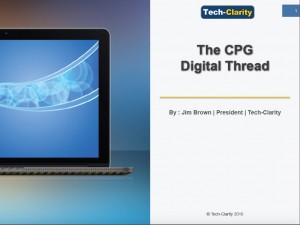 The The CPG Digital Thread ebook shares how consumer packaged goods (CPG) companies can streamline their product innovation and commercialization practices by innovating along the digital thread. It shares how companies can simultaneously enable R&D to innovate more efficiently while capturing the resulting IP as a reusable corporate asset by leveraging an integrated product innovation platform to create the digital thread.
Please enjoy the summary below, or click the report or title to download the full PDF (free of charge, no registration required) sponsored by Dassault Systemes.
Also see the Consumer Goods Technology webcast New Approaches to Improve Product Development (free of charge, no registration required), also sponsored by Dassault Systemes.
The The CPG Digital Thread ebook shares how consumer packaged goods (CPG) companies can streamline their product innovation and commercialization practices by innovating along the digital thread. It shares how companies can simultaneously enable R&D to innovate more efficiently while capturing the resulting IP as a reusable corporate asset by leveraging an integrated product innovation platform to create the digital thread.
Please enjoy the summary below, or click the report or title to download the full PDF (free of charge, no registration required) sponsored by Dassault Systemes.
Also see the Consumer Goods Technology webcast New Approaches to Improve Product Development (free of charge, no registration required), also sponsored by Dassault Systemes.
Innovate Along the Digital Thread
CPG companies have the opportunity to step up their product innovation processes and productivity to compete in crowded, competitive markets. In order to do that, they can leverage the digital thread to:
- Enable individual contributors with the right tools
- Integrate design tools within a product innovation platform that serves as the digital thread backbone
- Keep resulting information in context from early ideas through production and commercialization
- Make product information readily searchable to leverage product IP company wide
- Enable easier, more social collaboration
- Automate and streamline product documentation
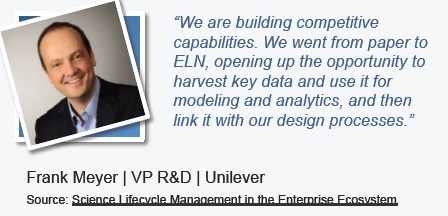 Of course this can’t be done with today’s disconnected tools, data, and office productivity tools like documents, presentations, and spreadsheets. As PLM for CPG, Personal Care, and Cosmetics advises, “Understand that spreadsheets and shared folders are not enough to fuel the speed and throughput requirements to remain competitive in formula-based industries.” Science Lifecycle Management in the Enterprise Ecosystem goes further, explaining that “Disjointed solutions and lack of integration leads to inefficiency, inability to reuse lab results, difficulty running analytics to find trends, and no mechanism to leverage scientific knowledge to become a ‘learning organization’ that leverages its scientific know-how.”
Of course this can’t be done with today’s disconnected tools, data, and office productivity tools like documents, presentations, and spreadsheets. As PLM for CPG, Personal Care, and Cosmetics advises, “Understand that spreadsheets and shared folders are not enough to fuel the speed and throughput requirements to remain competitive in formula-based industries.” Science Lifecycle Management in the Enterprise Ecosystem goes further, explaining that “Disjointed solutions and lack of integration leads to inefficiency, inability to reuse lab results, difficulty running analytics to find trends, and no mechanism to leverage scientific knowledge to become a ‘learning organization’ that leverages its scientific know-how.”
Instead, the digital thread removes the burden from innovators while creating a manageable IP asset that provides value well into the future, resulting in better corporate IP, more time for innovators to innovate, fewer recalls, faster time-to-market, higher productivity, and happy consumers. The time for the digital thread to transform product innovation and delight consumers has arrived. Consumer Packaged Goods Companies that don’t move toward a digital thread enabled by a product innovation platform will be at a disadvantage.
[post_title] => The CPG Digital Thread [post_excerpt] => [post_status] => publish [comment_status] => open [ping_status] => open [post_password] => [post_name] => cpg-digital-thread [to_ping] => [pinged] => [post_modified] => 2022-11-14 22:27:46 [post_modified_gmt] => 2022-11-15 03:27:46 [post_content_filtered] => [post_parent] => 0 [guid] => http://tech-clarity.com/?p=4961 [menu_order] => 0 [post_type] => post [post_mime_type] => [comment_count] => 1 [filter] => raw ) [15] => WP_Post Object ( [ID] => 4956 [post_author] => 2 [post_date] => 2016-01-04 18:16:42 [post_date_gmt] => 2016-01-04 23:16:42 [post_content] => Jim Brown offers some advice on selecting PLM systems in this TechTarget article Choosing a PLM System for Your Company? Start with Strategy. The report includes a requirements framework you can use to select the right vendor partner.
This is part three of a four part series. Prior article What can PLM technology dor for Enterprises? explores the benefits of PLM and PLM tools can cure and prevent product development ailments describes who can benefit from Product Lifecycle Management.
Jim Brown offers some advice on selecting PLM systems in this TechTarget article Choosing a PLM System for Your Company? Start with Strategy. The report includes a requirements framework you can use to select the right vendor partner.
This is part three of a four part series. Prior article What can PLM technology dor for Enterprises? explores the benefits of PLM and PLM tools can cure and prevent product development ailments describes who can benefit from Product Lifecycle Management.
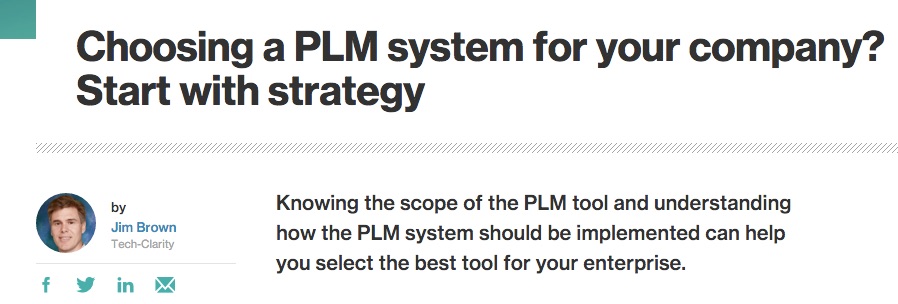 [post_title] => Choosing a PLM System? Start with Strategy!
[post_excerpt] =>
[post_status] => publish
[comment_status] => open
[ping_status] => open
[post_password] =>
[post_name] => tech-target-3
[to_ping] =>
[pinged] =>
[post_modified] => 2022-11-14 22:25:53
[post_modified_gmt] => 2022-11-15 03:25:53
[post_content_filtered] =>
[post_parent] => 0
[guid] => http://tech-clarity.com/?p=4956
[menu_order] => 0
[post_type] => post
[post_mime_type] =>
[comment_count] => 0
[filter] => raw
)
[16] => WP_Post Object
(
[ID] => 4946
[post_author] => 2
[post_date] => 2015-12-10 10:39:20
[post_date_gmt] => 2015-12-10 15:39:20
[post_content] => Jim Brown contributed a guest post to the Dassault Systèmes blog sharing some research on PLM for midsize manufacturing companies. The post explains how these smaller companies sometimes feel stuck between the need for a full featured PLM system to get their engineering and product development processes under control and less capable file-sharing systems that are easier to adopt but don't provide the capabilities they need.
Read the post on the 3DS blog now.
[post_title] => Choosing a PLM System? Start with Strategy!
[post_excerpt] =>
[post_status] => publish
[comment_status] => open
[ping_status] => open
[post_password] =>
[post_name] => tech-target-3
[to_ping] =>
[pinged] =>
[post_modified] => 2022-11-14 22:25:53
[post_modified_gmt] => 2022-11-15 03:25:53
[post_content_filtered] =>
[post_parent] => 0
[guid] => http://tech-clarity.com/?p=4956
[menu_order] => 0
[post_type] => post
[post_mime_type] =>
[comment_count] => 0
[filter] => raw
)
[16] => WP_Post Object
(
[ID] => 4946
[post_author] => 2
[post_date] => 2015-12-10 10:39:20
[post_date_gmt] => 2015-12-10 15:39:20
[post_content] => Jim Brown contributed a guest post to the Dassault Systèmes blog sharing some research on PLM for midsize manufacturing companies. The post explains how these smaller companies sometimes feel stuck between the need for a full featured PLM system to get their engineering and product development processes under control and less capable file-sharing systems that are easier to adopt but don't provide the capabilities they need.
Read the post on the 3DS blog now.
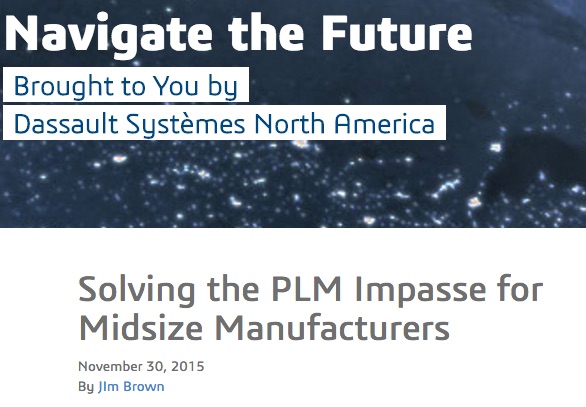 [post_title] => Solving the PLM Impasse for Midsize Manufacturers - Guest Post on Dassault Systemes
[post_excerpt] =>
[post_status] => publish
[comment_status] => open
[ping_status] => open
[post_password] =>
[post_name] => plm-smb
[to_ping] =>
[pinged] =>
[post_modified] => 2022-11-14 22:25:59
[post_modified_gmt] => 2022-11-15 03:25:59
[post_content_filtered] =>
[post_parent] => 0
[guid] => http://tech-clarity.com/?p=4946
[menu_order] => 0
[post_type] => post
[post_mime_type] =>
[comment_count] => 0
[filter] => raw
)
[17] => WP_Post Object
(
[ID] => 4941
[post_author] => 2
[post_date] => 2015-12-08 13:19:01
[post_date_gmt] => 2015-12-08 18:19:01
[post_content] =>
[post_title] => Solving the PLM Impasse for Midsize Manufacturers - Guest Post on Dassault Systemes
[post_excerpt] =>
[post_status] => publish
[comment_status] => open
[ping_status] => open
[post_password] =>
[post_name] => plm-smb
[to_ping] =>
[pinged] =>
[post_modified] => 2022-11-14 22:25:59
[post_modified_gmt] => 2022-11-15 03:25:59
[post_content_filtered] =>
[post_parent] => 0
[guid] => http://tech-clarity.com/?p=4946
[menu_order] => 0
[post_type] => post
[post_mime_type] =>
[comment_count] => 0
[filter] => raw
)
[17] => WP_Post Object
(
[ID] => 4941
[post_author] => 2
[post_date] => 2015-12-08 13:19:01
[post_date_gmt] => 2015-12-08 18:19:01
[post_content] =>  Jim Brown shares the value and benefits of PLM in this TechTarget article PLM tools can cure and prevent product development ailments, answering the question "who can benefit from Product Lifecycle Management?" in part two of this four part series.
Jim Brown shares the value and benefits of PLM in this TechTarget article PLM tools can cure and prevent product development ailments, answering the question "who can benefit from Product Lifecycle Management?" in part two of this four part series.
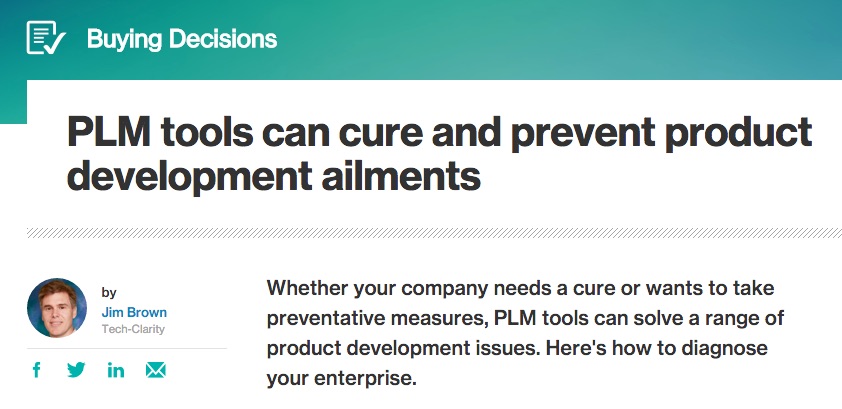 [post_title] => PLM Cures and Prevents Product Development Ailments - TechTarget Article
[post_excerpt] =>
[post_status] => publish
[comment_status] => open
[ping_status] => open
[post_password] =>
[post_name] => plm-techtarget-2
[to_ping] =>
[pinged] =>
[post_modified] => 2022-11-14 22:25:52
[post_modified_gmt] => 2022-11-15 03:25:52
[post_content_filtered] =>
[post_parent] => 0
[guid] => http://tech-clarity.com/?p=4941
[menu_order] => 0
[post_type] => post
[post_mime_type] =>
[comment_count] => 0
[filter] => raw
)
[18] => WP_Post Object
(
[ID] => 4930
[post_author] => 2
[post_date] => 2015-12-02 13:39:51
[post_date_gmt] => 2015-12-02 18:39:51
[post_content] =>
[post_title] => PLM Cures and Prevents Product Development Ailments - TechTarget Article
[post_excerpt] =>
[post_status] => publish
[comment_status] => open
[ping_status] => open
[post_password] =>
[post_name] => plm-techtarget-2
[to_ping] =>
[pinged] =>
[post_modified] => 2022-11-14 22:25:52
[post_modified_gmt] => 2022-11-15 03:25:52
[post_content_filtered] =>
[post_parent] => 0
[guid] => http://tech-clarity.com/?p=4941
[menu_order] => 0
[post_type] => post
[post_mime_type] =>
[comment_count] => 0
[filter] => raw
)
[18] => WP_Post Object
(
[ID] => 4930
[post_author] => 2
[post_date] => 2015-12-02 13:39:51
[post_date_gmt] => 2015-12-02 18:39:51
[post_content] =>  Jim Brown contributes his views on PLM and how it helps manufacturers in this TechTarget article What can PLM technology dor for Enterprises.
Jim Brown contributes his views on PLM and how it helps manufacturers in this TechTarget article What can PLM technology dor for Enterprises.
 [post_title] => What PLM can do for Enterprises - TechTarget Article
[post_excerpt] =>
[post_status] => publish
[comment_status] => open
[ping_status] => open
[post_password] =>
[post_name] => plm-techtarget-1
[to_ping] =>
[pinged] =>
[post_modified] => 2022-11-14 22:25:52
[post_modified_gmt] => 2022-11-15 03:25:52
[post_content_filtered] =>
[post_parent] => 0
[guid] => http://tech-clarity.com/?p=4930
[menu_order] => 0
[post_type] => post
[post_mime_type] =>
[comment_count] => 0
[filter] => raw
)
[19] => WP_Post Object
(
[ID] => 4920
[post_author] => 2
[post_date] => 2015-11-20 11:15:19
[post_date_gmt] => 2015-11-20 16:15:19
[post_content] => Jim Brown and Dassault Systémes' VP Kendall Pond will present on this Engineering.com webcast sharing insights on the value of PLM for aerospace and automative suppliers that have outgrown their informal data management approaches. Companies in the auto and aero supply chains can learn how to better manage data, processes, and collaboration with Product Lifecycle Management, and how it can help them create a digital continuity from concept to through retirement.
[post_title] => What PLM can do for Enterprises - TechTarget Article
[post_excerpt] =>
[post_status] => publish
[comment_status] => open
[ping_status] => open
[post_password] =>
[post_name] => plm-techtarget-1
[to_ping] =>
[pinged] =>
[post_modified] => 2022-11-14 22:25:52
[post_modified_gmt] => 2022-11-15 03:25:52
[post_content_filtered] =>
[post_parent] => 0
[guid] => http://tech-clarity.com/?p=4930
[menu_order] => 0
[post_type] => post
[post_mime_type] =>
[comment_count] => 0
[filter] => raw
)
[19] => WP_Post Object
(
[ID] => 4920
[post_author] => 2
[post_date] => 2015-11-20 11:15:19
[post_date_gmt] => 2015-11-20 16:15:19
[post_content] => Jim Brown and Dassault Systémes' VP Kendall Pond will present on this Engineering.com webcast sharing insights on the value of PLM for aerospace and automative suppliers that have outgrown their informal data management approaches. Companies in the auto and aero supply chains can learn how to better manage data, processes, and collaboration with Product Lifecycle Management, and how it can help them create a digital continuity from concept to through retirement.
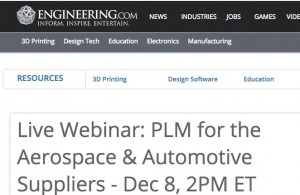 Listen to the recorded webcast now. Free of charge, registration required. Sponsored by Dassault Systemes
Listen to the recorded webcast now. Free of charge, registration required. Sponsored by Dassault Systemes
 [post_title] => Webinar on PLM For Auto and Aero Suppliers
[post_excerpt] =>
[post_status] => publish
[comment_status] => open
[ping_status] => open
[post_password] =>
[post_name] => webinar-aero-auto-plm
[to_ping] =>
[pinged] =>
[post_modified] => 2022-11-14 22:26:43
[post_modified_gmt] => 2022-11-15 03:26:43
[post_content_filtered] =>
[post_parent] => 0
[guid] => http://tech-clarity.com/?p=4920
[menu_order] => 0
[post_type] => post
[post_mime_type] =>
[comment_count] => 0
[filter] => raw
)
)
[post_count] => 20
[current_post] => -1
[before_loop] => 1
[in_the_loop] =>
[post] => WP_Post Object
(
[ID] => 5252
[post_author] => 2572
[post_date] => 2016-04-12 12:36:58
[post_date_gmt] => 2016-04-12 16:36:58
[post_content] => Michelle Boucher shares six reasons why product development projects fail and they all stem from poor requirements management. The guest post titled 6 Reasons Your Projects Fail: How Requirements Management Can Help on the PTC Integrity blog, explores the impact of these six challenges on project success and discusses various ways poor requirements management can derail a project.
Read the post on the PTC blog now.
[post_title] => Webinar on PLM For Auto and Aero Suppliers
[post_excerpt] =>
[post_status] => publish
[comment_status] => open
[ping_status] => open
[post_password] =>
[post_name] => webinar-aero-auto-plm
[to_ping] =>
[pinged] =>
[post_modified] => 2022-11-14 22:26:43
[post_modified_gmt] => 2022-11-15 03:26:43
[post_content_filtered] =>
[post_parent] => 0
[guid] => http://tech-clarity.com/?p=4920
[menu_order] => 0
[post_type] => post
[post_mime_type] =>
[comment_count] => 0
[filter] => raw
)
)
[post_count] => 20
[current_post] => -1
[before_loop] => 1
[in_the_loop] =>
[post] => WP_Post Object
(
[ID] => 5252
[post_author] => 2572
[post_date] => 2016-04-12 12:36:58
[post_date_gmt] => 2016-04-12 16:36:58
[post_content] => Michelle Boucher shares six reasons why product development projects fail and they all stem from poor requirements management. The guest post titled 6 Reasons Your Projects Fail: How Requirements Management Can Help on the PTC Integrity blog, explores the impact of these six challenges on project success and discusses various ways poor requirements management can derail a project.
Read the post on the PTC blog now.
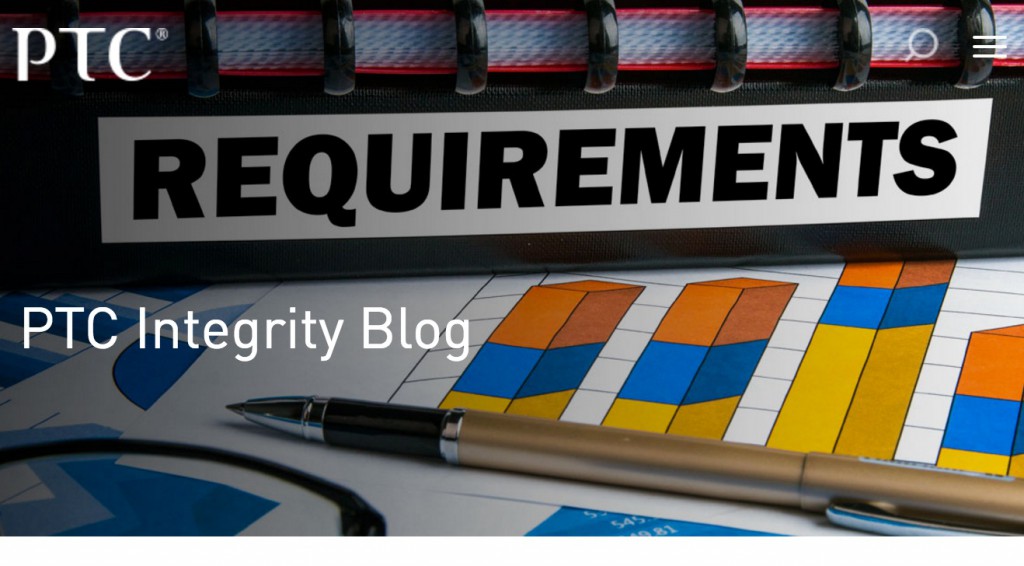
 [post_title] => 6 Reasons Your Projects Fail - Guest Post on PTC Blog
[post_excerpt] =>
[post_status] => publish
[comment_status] => open
[ping_status] => open
[post_password] =>
[post_name] => why-projects-fail
[to_ping] =>
[pinged] =>
[post_modified] => 2022-11-14 22:26:00
[post_modified_gmt] => 2022-11-15 03:26:00
[post_content_filtered] =>
[post_parent] => 0
[guid] => http://tech-clarity.com/?p=5252
[menu_order] => 0
[post_type] => post
[post_mime_type] =>
[comment_count] => 0
[filter] => raw
)
[comment_count] => 0
[current_comment] => -1
[found_posts] => 802
[max_num_pages] => 41
[max_num_comment_pages] => 0
[is_single] =>
[is_preview] =>
[is_page] =>
[is_archive] =>
[is_date] =>
[is_year] =>
[is_month] =>
[is_day] =>
[is_time] =>
[is_author] =>
[is_category] =>
[is_tag] =>
[is_tax] =>
[is_search] =>
[is_feed] =>
[is_comment_feed] =>
[is_trackback] =>
[is_home] => 1
[is_privacy_policy] =>
[is_404] =>
[is_embed] =>
[is_paged] =>
[is_admin] =>
[is_attachment] =>
[is_singular] =>
[is_robots] =>
[is_favicon] =>
[is_posts_page] =>
[is_post_type_archive] =>
[query_vars_hash:WP_Query:private] => 35f8ccd7f3466a9ab93e17d7c50b97bd
[query_vars_changed:WP_Query:private] => 1
[thumbnails_cached] =>
[allow_query_attachment_by_filename:protected] =>
[stopwords:WP_Query:private] =>
[compat_fields:WP_Query:private] => Array
(
[0] => query_vars_hash
[1] => query_vars_changed
)
[compat_methods:WP_Query:private] => Array
(
[0] => init_query_flags
[1] => parse_tax_query
)
[query_cache_key:WP_Query:private] => wp_query:8b3561ce4456eb0949320f423b0c2872:0.47823800 17646571910.48756100 1764657191
)
[post_title] => 6 Reasons Your Projects Fail - Guest Post on PTC Blog
[post_excerpt] =>
[post_status] => publish
[comment_status] => open
[ping_status] => open
[post_password] =>
[post_name] => why-projects-fail
[to_ping] =>
[pinged] =>
[post_modified] => 2022-11-14 22:26:00
[post_modified_gmt] => 2022-11-15 03:26:00
[post_content_filtered] =>
[post_parent] => 0
[guid] => http://tech-clarity.com/?p=5252
[menu_order] => 0
[post_type] => post
[post_mime_type] =>
[comment_count] => 0
[filter] => raw
)
[comment_count] => 0
[current_comment] => -1
[found_posts] => 802
[max_num_pages] => 41
[max_num_comment_pages] => 0
[is_single] =>
[is_preview] =>
[is_page] =>
[is_archive] =>
[is_date] =>
[is_year] =>
[is_month] =>
[is_day] =>
[is_time] =>
[is_author] =>
[is_category] =>
[is_tag] =>
[is_tax] =>
[is_search] =>
[is_feed] =>
[is_comment_feed] =>
[is_trackback] =>
[is_home] => 1
[is_privacy_policy] =>
[is_404] =>
[is_embed] =>
[is_paged] =>
[is_admin] =>
[is_attachment] =>
[is_singular] =>
[is_robots] =>
[is_favicon] =>
[is_posts_page] =>
[is_post_type_archive] =>
[query_vars_hash:WP_Query:private] => 35f8ccd7f3466a9ab93e17d7c50b97bd
[query_vars_changed:WP_Query:private] => 1
[thumbnails_cached] =>
[allow_query_attachment_by_filename:protected] =>
[stopwords:WP_Query:private] =>
[compat_fields:WP_Query:private] => Array
(
[0] => query_vars_hash
[1] => query_vars_changed
)
[compat_methods:WP_Query:private] => Array
(
[0] => init_query_flags
[1] => parse_tax_query
)
[query_cache_key:WP_Query:private] => wp_query:8b3561ce4456eb0949320f423b0c2872:0.47823800 17646571910.48756100 1764657191
)
All Results for "All"
Finding PLM to Fit Midsized Manufacturers eBook
Our Finding PLM to Fit Midsized Manufacturers eBook explains how smaller companies find themselves stuck between full-featured PLM systems that feel out of reach and less capable solutions including cloud-based file sharing or very basic data management applications. They know they can’t afford the errors and inefficiency inherent to informal data and process management, but can’t…
3D Printing Panel Discussion at Microsoft Envision
At Microsoft Envision, Tech-Clarity’s Michelle Boucher will chair a panel that includes: Luis Baldez, Software Strategy Program Manager, 3D Printing, HP Prabhjot Singh, Manager, Additive Manufacturing Lab, GE Global Research Simon Floyd, Director Strategy, Product Lifecycle Management, Microsoft Microsoft Envision takes place in New Orleans to April 4 – April 6. The panel discussion will explore…
Simulation Study: Empowering Innovation
This survey is now closed. Please check out our Active Research page for additional Tech-Clarity survey opportunities. How do leading companies empower design engineers with simulation? Please share your experience. We are conducting new research on simulation and exploring questions such as how does simulation help design engineers? What are the best ways to help design engineers adopt…
How to Empower R&D and Engineering Teams to Innovate with New Materials
How to Empower R&D and Engineering Teams to Innovate with New Materials: Secrets to Growing Revenue and Increasing Profit Margins identifies six lessons to help companies innovate to secure future revenue streams, while managing risk. The study examines how new materials can help companies innovate and how more successful companies take advantage of the latest developments in…
Optimizing the Bidding Process
Optimizing the Bidding Process: How Industrial Equipment Manufacturers Can Win More Business focuses on the importance of getting the bidding process right. Bids require a quick response, yet must be competitively priced, without sacrificing margins. Getting this right is a challenge for many companies, but is especially difficult for businesses such as industrial equipment manufacturers offering Engineer-to-Order…
Infographic: Improving Concept Design to Boost Revenue
The concept phase is critical for innovation. Tech-Clarity’s Improving Concept Design to Boost Revenue infographic steps through what companies attempt to achieve during the concept phase, how the most successful companies approach concept development, and the benefits they enjoy as a result. Additional information can be found in our related research report, Improving Concept Design: Innovating at the Front End to Drive…
Preparing Industrial Equipment Manufacturers for Growth
Preparing Industrial Equipment Manufacturers for Growth: Innovating Future Product Lines with Higher Margins identifies how industrial equipment manufacturers can transform their business to a position of growth by implementing a strategy for innovation, without investing in additional resources. With the right approach to innovation, companies will ensure future revenue streams, while managing risk. Getting this right is…
What’s the Strategic Payback from PDM? (animation)
This short Tech-Clarity TV animation explains the strategic, financial value of PDM. Most companies get plenty of cost savings that justify the investment in PDM, but should also recognize the strategic, top-line benefits that PDM delivers. This episode is sponsored by Siemens PLM. Learn more about Siemens PLM and their Teamcenter Rapid Start Program or see…
Improving Concept Design
Improving Concept Design: Innovating at the Front End to Drive Revenue Opportunities examines the importance of the concept phase. The report reveals survey results highlighting not only what companies can do to improve the concept phase, but also how to take advantage of concept work during later stages of product development. Please enjoy the summary below, or click the report or…
Improving Profitability for Configured Products
Improving Profitability for Configured Products: Leveraging Sales Configuration and Design Automation explores how companies can profitability tailor products to meet customer needs. The research investigates the experiences of several companies, revealing several key areas companies should focus on to improve their profitability. Please enjoy the summary below, or click the report to download a PDF overview (free…
Selecting the Right PLM Partner
Jim Brown offers some advice on selecting PLM systems in this TechTarget article A PLM Systems Comparison of the Industry’s Top Tools. The report also shares some insights on the leading PLM vendors. This is the final article of a four part series. Prior article What can PLM technology dor for Enterprises? explores the benefits of PLM and PLM tools…
Webcast Driving a Competitive Edge Through Customization
Jim Brown joins Mark Rogers of Price HVAC and Rick Smith of Siemens PLM to discuss how to improve ETO processes and performance. Jim will share findings from a recent survey on what strategies, best practices, and enabling technologies top performing manufacturers use to gain higher profits from their customized products. Register now (free of charge, registration required)…
Are You Changing CAD Tools?
Are You Changing CAD Tools? What You Should Know shares survey results exploring the motivating factors behind changing CAD tools as well what companies can expect when making a change. The research examines the experiences of companies who have gone through a CAD change. It reveals key metrics such as the how much legacy data companies convert, how long to resume full productivity, and…
The CPG Digital Thread
The The CPG Digital Thread ebook shares how consumer packaged goods (CPG) companies can streamline their product innovation and commercialization practices by innovating along the digital thread. It shares how companies can simultaneously enable R&D to innovate more efficiently while capturing the resulting IP as a reusable corporate asset by leveraging an integrated product innovation platform to create the digital…
Choosing a PLM System? Start with Strategy!
Jim Brown offers some advice on selecting PLM systems in this TechTarget article Choosing a PLM System for Your Company? Start with Strategy. The report includes a requirements framework you can use to select the right vendor partner. This is part three of a four part series. Prior article What can PLM technology dor for Enterprises? explores the…
Solving the PLM Impasse for Midsize Manufacturers – Guest Post on Dassault Systemes
Jim Brown contributed a guest post to the Dassault Systèmes blog sharing some research on PLM for midsize manufacturing companies. The post explains how these smaller companies sometimes feel stuck between the need for a full featured PLM system to get their engineering and product development processes under control and less capable file-sharing systems that…
PLM Cures and Prevents Product Development Ailments – TechTarget Article
Jim Brown shares the value and benefits of PLM in this TechTarget article PLM tools can cure and prevent product development ailments, answering the question “who can benefit from Product Lifecycle Management?” in part two of this four part series.
What PLM can do for Enterprises – TechTarget Article
Jim Brown contributes his views on PLM and how it helps manufacturers in this TechTarget article What can PLM technology dor for Enterprises.
Webinar on PLM For Auto and Aero Suppliers
Jim Brown and Dassault Systémes‘ VP Kendall Pond will present on this Engineering.com webcast sharing insights on the value of PLM for aerospace and automative suppliers that have outgrown their informal data management approaches. Companies in the auto and aero supply chains can learn how to better manage data, processes, and collaboration with Product Lifecycle…

